Explore Da Nang - Central Vietnam Travel, Asia
Tucked down in the center of Vietnam's coastline, Da Nang is a dynamic fusion of contemporary appeal and old-world charm. This coastal city, known for its stunning beaches, rich history, and dynamic cultural scene, offers something for every traveler. Whether you’re drawn by its historical significance, eager to interact with friendly locals, or ready to dive into its diverse attractions, Da Nang is a destination that promises to captivate and inspire.
Population: Approximately 1.2 million in 2022.
Economy: The leading industrial hub in Central Vietnam and the third largest economic metropolitan in the country beside Ho Chi Minh City and Hanoi.
Landmarks: Famous for My Khe Beach, Ba Na Hills, and My Son Sanctuary.
Vietnam

Overview of Da Nang
History & Culture Influence
Da Nang's history stretches back to the Champa Kingdom, an ancient civilization that thrived between the 4th and 13th centuries. As a key port city, Da Nang was central to the Champa's maritime trade. The city's colonial past also left a lasting mark, as it was a major French port during the late 19th and early 20th centuries. The rich culture of Da Nang is woven from the threads of its Cham, Vietnamese, and French heritage. The Cham influence is evident in the ancient ruins of My Son Sanctuary, a UNESCO World Heritage site that showcases intricate Cham architecture and carvings. French colonial architecture, such as the Da Nang Cathedral with its distinctive pink facade, adds a European charm to the cityscape.
Blend in the local culture with our brand new itineraries of Vietnam tour here.
Interaction with The Locals
Da Nang, one of Vietnam's major cities, has a population of approximately 1.2 million residents. As a vibrant urban center, it attracts a diverse mix of locals and expatriates, contributing to its dynamic culture. The citizens of Da Nang are known for their friendliness and hospitality. With a blend of traditional Vietnamese values and modern influences, they play a crucial role in making the city welcoming to visitors. The local community is actively involved in preserving cultural heritage while embracing progress and development.
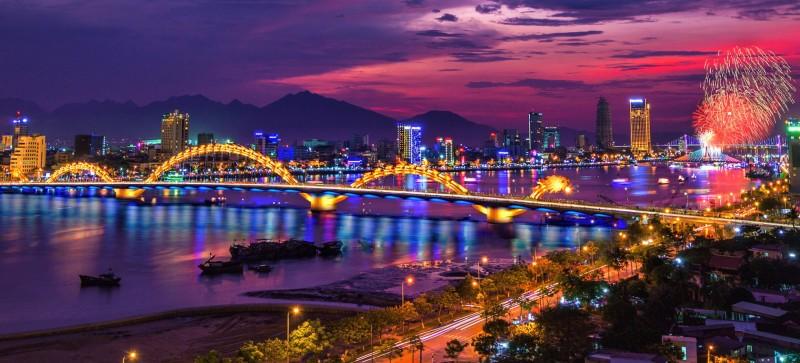
Dragon Bridge - © DanNang Tourism
Top Attractions in Da Nang
Da Nang is a city of contrasts, where stunning natural landscapes meet impressive modern landmarks. Whether you’re drawn to serene beaches or towering monuments, Da Nang has something for every traveler.
Da Nang Natural Wonders
- My Khe Beach: Renowned for its fine golden sand and clear blue waters, My Khe Beach is ideal for swimming, sunbathing, and enjoying water sports. Its tranquil environment makes it a perfect spot for relaxation.
- Ba Na Hills: Located about 30 kilometers from Da Nang, Ba Na Hills is famous for its stunning views and the iconic Golden Bridge, held aloft by colossal stone hands. The area also features a French-style village, beautiful gardens, and an impressive cable car ride.
- Marble Mountains: This cluster of five marble and limestone hills is a must-visit. Discover the enigmatic caverns, pagodas, and stunning vantage spots that provide expansive views of Da Nang and the surrounding area.
Da Nang Historical Sites
- Dragon Bridge: Spanning the Han River, the Dragon Bridge is a modern engineering marvel with traditional dragon motifs. On weekends, it comes alive with a spectacular fire and water show.
- Linh Ung Pagoda: This significant Buddhist temple, located on the Son Tra Peninsula, is home to the Lady Buddha statue, which stands at 67 meters tall. The pagoda offers tranquil surroundings and panoramic views of Da Nang.
- My Son Sanctuary: Although a bit of a drive from Da Nang, My Son Sanctuary is worth the trip. This UNESCO World Heritage site consists of a series of ancient Hindu temples built by the Champa Kingdom, showcasing intricate carvings and historical significance.
Da Nang Modern Attractions
- Sun Wheel: Located in Asia Park, the Sun Wheel is one of the world’s largest Ferris wheels. It provides panoramic views of Da Nang’s skyline and the surrounding area.
- Da Nang Museum of Cham Sculpture: Dedicated to preserving and showcasing Cham artifacts, this museum houses one of the world's most comprehensive collections of Cham sculpture, offering insights into the ancient Champa civilization.
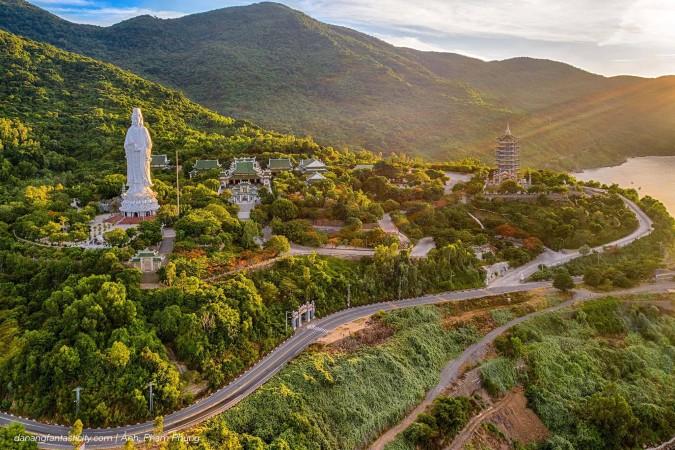
Linh Ung Pagoda - © DaNang Tourism
Must-Try Dishes in Da Nang
The colorful fusion of tastes and textures found in Da Nang's food is a reflection of the city's rich cultural past. Renowned for its diverse and flavorful dishes, the city's culinary tradition is influenced by its coastal location, offering fresh seafood and unique regional flavors.
- Mi Quang: This is Da Nang’s signature noodle dish, featuring flat rice noodles in a rich, turmeric-infused broth. Topped with a mix of pork, shrimp, or chicken, along with fresh herbs, peanuts, and crispy rice crackers, Mi Quang is both hearty and flavorful.
- Bun Cha Ca: A savory fish cake noodle soup, Bun Cha Ca is known for its delicate fish cakes and aromatic broth. Garnished with fresh herbs and served with rice noodles, it's a comforting and delicious meal.
- Banh Xeo: Often referred to as Vietnamese pancakes, Banh Xeo are crispy, savory crepes filled with pork, shrimp, and bean sprouts. Wrapped in lettuce leaves and dipped in a tangy fish sauce, they offer a delightful blend of textures and flavors.
- Nem Lui: Grilled pork skewers, or Nem Lui, are a popular street food in Da Nang. The minced pork is mixed with spices, molded onto skewers, and grilled to perfection. Typically served with rice paper, fresh herbs, and a dipping sauce, Nem Lui is a tasty treat.
- Banh Beo: Tiny steamed rice cakes with a flavorful blend of crispy pig skin, scallions, and shrimp on top. These little cakes are served with fish sauce and offer a delightful combination of textures and flavors.
- Chao Tom: Grilled shrimp paste on sugarcane, Chao Tom is a unique dish where minced shrimp is wrapped around sugarcane stalks and grilled. The shrimp takes on a sweet, smoky flavor from the grilling, making it a delicious appetizer or main course.
In love with Vietnamese dishes? Check out more unique regional cuisine in Can Tho here.
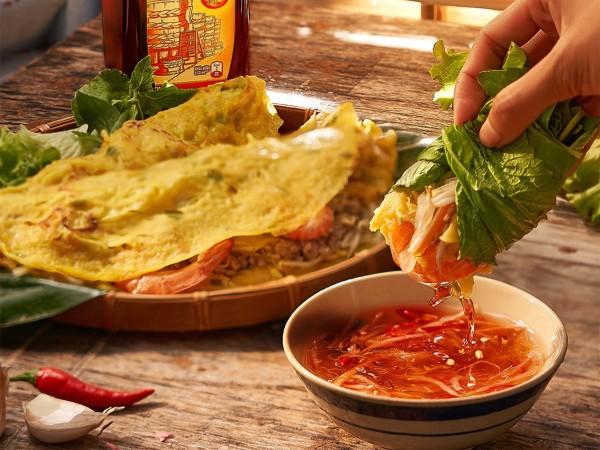
Banh Xeo (Vietnamese pancakes) with nuoc cham - © Knorr
Festivals & Local Celebrations
Da Nang's calendar is filled with colorful festivals and lively celebrations that reflect the city’s rich cultural heritage and communal spirit. These gatherings provide guests a special look into regional customs and make lasting impressions.
Major Festivals
- Da Nang International Fireworks Festival: Held annually, this spectacular event lights up the night sky with dazzling fireworks displays. Featuring teams from all around the world, the event creates a lively environment along the Han River, drawing thousands of people watching.
- Tet Holiday (Lunar New Year): Tet, Vietnam's most important holiday, is celebrated with great enthusiasm in Da Nang. The city comes alive with traditional performances, vibrant parades, and elaborate decorations. Visitors can experience the local customs, enjoy traditional foods, and witness cultural ceremonies.
Local Events
- Mid-Autumn Festival: This family-oriented festival, celebrated in September, is marked by colorful lanterns, traditional mooncakes, and lively street performances. Da Nang’s streets are adorned with lanterns, and various cultural activities take place, making it a festive time to visit.
- Da Nang Carnival: An annual event featuring parades, music, and dance performances. With its colorful costumes, street performers, and energetic environment that perfectly encapsulates Da Nang's joyous attitude, the carnival honors the city's rich cultural heritage.
Shopping in Da Nang
Da Nang offers a diverse shopping experience, from bustling markets to modern shopping malls. Whether you’re looking for souvenirs, local crafts, or high-end goods, Da Nang has something for every shopper.
- Han Market: Located in the city center, Han Market is a vibrant place to shop for local produce, handicrafts, and souvenirs. It's a wonderful place to discover distinctive goods and take in the local ambience.
- Con Market: Another popular market where you can find a wide range of local foods, clothing, and crafts. The market is well-known for both its wide selection of goods and its busy atmosphere.
- VinCom Plaza: A modern retail mall with a variety of local and international businesses, eateries, and entertainment venues. It's a well-liked location for recreation and shopping.
- Parkson Da Nang: A well-known mall offering a range of fashion, electronics, and lifestyle stores. It’s an ideal place for finding quality goods and enjoying a comfortable shopping environment.
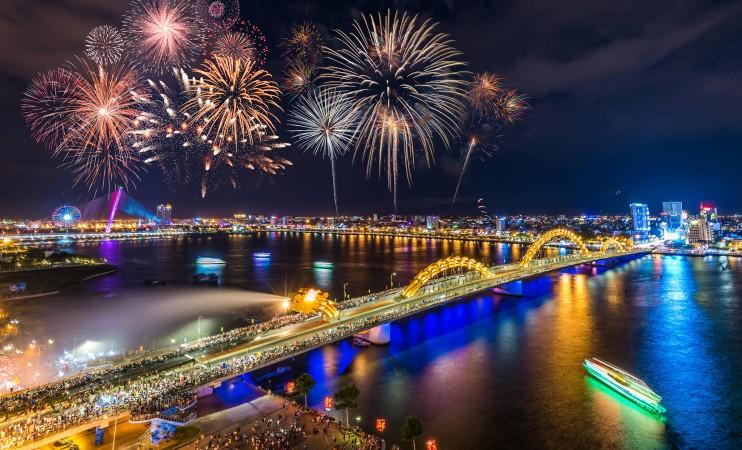
Da Nang International Fireworks Festival - © Vietnam Tourism
What to Do in Da Nang
Da Nang offers a wide range of activities that cater to different interests, from outdoor adventures to cultural experiences. Here’s a selection of activities that will make your visit memorable.
Outdoor Activities
- Beach Fun: Enjoy the sun and surf at My Khe Beach and Non Nuoc Beach. These pristine beaches are perfect for swimming, sunbathing, and water sports like surfing and jet skiing.
- Hiking in Son Tra: Explore the lush trails of the Son Tra Peninsula. The peninsula offers various hiking routes with breathtaking views of Da Nang and opportunities to spot wildlife such as the rare red-shanked douc langur.
- Ba Na Hills Adventure: Take a cable car ride to the Ba Na Hills, where you can explore the French-style village, enjoy the Golden Bridge, and visit the Linh Ung Pagoda.
The weather in central Vietnam is perfect for visiting the beaches and hiking adventures. Learn more about a popular beach city in Vietnam, Nha Trang, here.
Cultural Exploration
- Explore My Son Sanctuary: Discover the ancient Cham ruins and learn about the Champa Kingdom’s history at this UNESCO World Heritage site.
- Explore Da Nang Museum of Cham Sculpture: View one of the world’s largest collections of Cham artifacts and sculptures, providing insights into the ancient Champa civilization.
- Han River Cruise: Savor a leisurely trip along the Han River, which offers breathtaking views of the city's skyline, lit-up bridges, and famous sites.
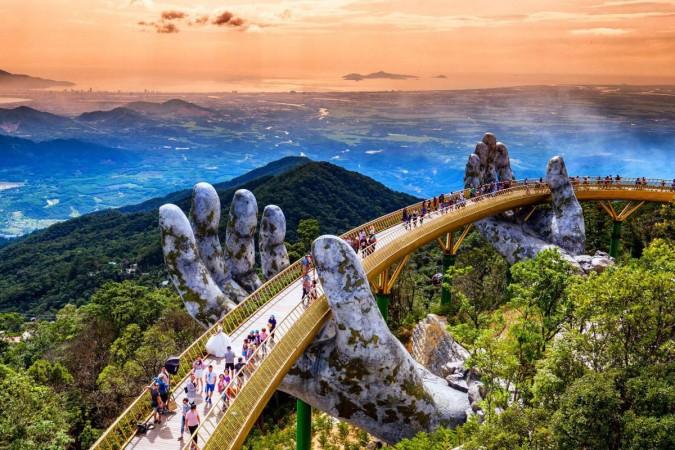
Golden Bridge in Ba Na Hills - © VnExpress
Weather in Da Nang: Best Time to Visit
Da Nang’s tropical climate significantly influences its tourism trends, with seasonal variations affecting visitor activities and preferences. This Vietnam’s coastal city enjoys warm temperatures year-round, with averages ranging from 25°C to 35°C (77°F to 95°F). The consistent warmth makes it a popular destination for beachgoers and outdoor enthusiasts at any time of the year.
Weather Conditions in Da Nang
- Rainy Season: From September to December, Da Nang experiences its rainy season. During this period, the city receives frequent showers and occasional storms. While the rain can be heavy, it generally comes in short bursts, allowing visitors to enjoy the lush green landscape and fewer crowds at major attractions. This season can offer lower accommodation rates and more relaxed travel experiences.
- Dry Season: The dry season, spanning from January to August, is characterized by minimal rainfall and sunny days. This is the peak tourist season, with ideal conditions for beach activities, outdoor exploration, and sightseeing. During these months, Da Nang is bustling with visitors, and attractions can be more crowded. Booking accommodations and tours in advance is advisable during this period.
Tourism Trends in Da Nang
- Best Time to Visit: For optimal weather and vibrant city life, the best time to visit Da Nang is from February to May. The warm, dry conditions are perfect for enjoying the city's beaches and outdoor activities. If you prefer a quieter, more cost-effective trip with lush landscapes, consider visiting during the rainy season from September to December.
- Off-Peak Advantages: The rainy season, though less popular, can be a great time for travelers seeking a quieter experience. With fewer tourists, you can explore attractions like My Son Sanctuary and the Marble Mountains with less crowding. Additionally, the lush landscapes created by the rains offer picturesque scenery for photographers.
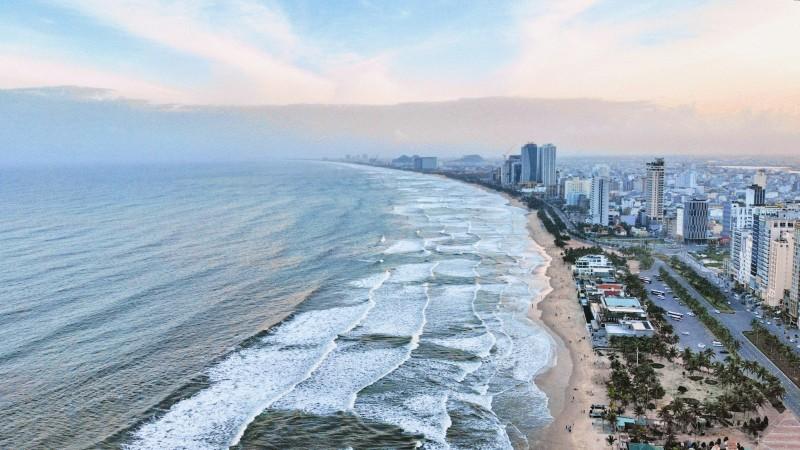
Da Nang beach off-peak season - © Thach Tran
Culture Etiquette in Da Nang
- Dress Modestly: When visiting temples and religious sites, dress modestly. It is respectful to cover your knees and shoulders, and avoid revealing clothes. When visiting temples and some residences, take off your shoes and avoid wearing anything too skimpy.
- Greeting Etiquette: A common greeting in Vietnam is a smile and a polite nod or handshake. In more formal settings, a slight bow of the head is also appreciated. Addressing people with their titles or adding “Mr.” or “Ms.” before their names shows respect.
- Table Manners: When you are dining, wait to start eating until the host has finished. Use chopsticks properly—avoid sticking them upright in rice or passing food directly from chopstick to chopstick, as these actions are considered impolite.
- Respect for Elders: Elders are highly respected in Vietnamese culture. When interacting with older individuals, show deference and allow them to speak first. Offering your seat to an elder or helping them is considered courteous.
- Public Behavior: Maintain a low volume in public spaces and avoid public displays of affection. Public behavior should be restrained, and it’s important to be mindful of local norms to avoid drawing unwanted attention.
- Tipping Custom: While tipping is not mandatory, it is appreciated in the service industry. It's polite to round up the bill or leave a little tip in restaurants. For taxi drivers and hotel staff, a small tip can also be a sign of appreciation for good service.
Essential Travel Information
Getting Around Da Nang
Navigating Da Nang is easy with its well-established transportation options. Taxis are widely available, offering a comfortable and flexible means of getting around; just be sure to use reputable services and check that the meter is running to avoid overcharging. For a more modern approach, ride-sharing apps provide convenient and transparent pricing. Motorbike rentals are popular for those seeking independence and adventure, allowing you to explore the city and its surroundings at your own pace. For a leisurely exploration of Da Nang's scenic spots and beaches, renting a bicycle is a fantastic option, with many hotels and rental shops providing this service.
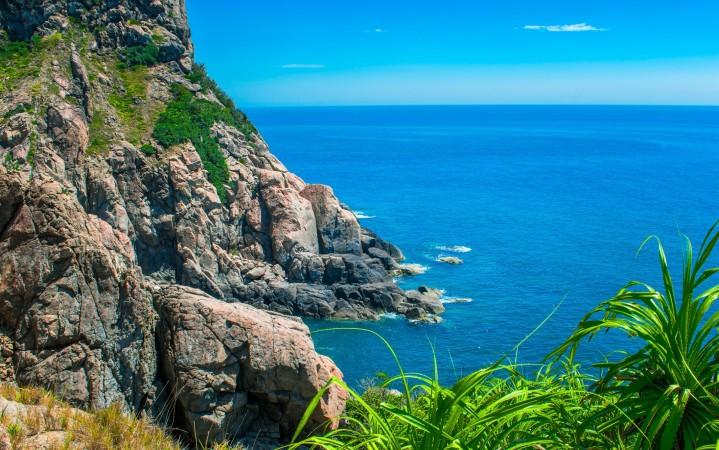
Beach view when hiking in Son Tra, Da Nang - © Toàn Vinh
ATM & Banking Services
Managing finances in Da Nang is straightforward with a range of banking services and ATMs scattered throughout the city. ATMs are conveniently located in tourist areas, shopping centers, and major streets, offering easy access to cash for daily needs. Most ATMs accept major international credit and debit cards, so it’s advisable to confirm with your bank that your card will work in Vietnam. For currency exchange and additional banking services, several local banks are available.
Where to Stay in Da Nang
Da Nang offers a diverse range of accommodation options to cater to various preferences and budgets. For those seeking luxury, five-star resorts provide opulent rooms, top-notch amenities, and breathtaking views, ideal for a relaxing getaway. Mid-range hotels offer modern comfort and convenient locations near popular attractions, featuring amenities like pools and dining options. Budget travelers will find clean and affordable guesthouses and hostels, which provide a social atmosphere and basic comforts. Additionally, boutique hotels in Da Nang offer a unique and personalized stay with distinctive decor and attentive service, perfect for those looking for a more intimate experience.
Articles for you

Explore Yala National Park - Sri Lanka Travel, Asia
Tucked away in Sri Lanka’s southeastern corner, Yala National Park is where wild nature meets deep tradition. Known worldwide for its leopard population, the park is also home to elephants, sloth bears, crocodiles, and hundreds of bird species. Beyond wildlife, Yala opens doors to a cultural landscape dotted with ancient temples, Buddhist ruins, and coastal villages. For travelers seeking more than just a safari, Yala offers a chance to explore eco-tourism, local communities, and sacred heritage sites.
Population: The Yala National Park area doesn’t have a human population.
Economy: The economy around Yala National Park thrives on a blend of eco-tourism, agriculture, and local services. Safari tours, eco-lodges, and cultural experiences drive steady income for nearby towns like Tissamaharama and Kataragama, supporting thousands of families.
Landmarks: Famous for Block I of Yala and wildlife encounters, including elephants, sloth bears, crocodiles, and exotic bird species.

Explore Galle - Sri Lanka Travel, Asia
Nestled on Sri Lanka’s southern coastline, Galle is a vibrant city where history meets the sea. Its cobbled streets, colonial architecture, and serene beaches make it a must-visit destination for travelers seeking a blend of culture, adventure, and relaxation. A UNESCO World Heritage site, Galle captivates visitors with its Dutch Fort, bustling markets, and friendly locals. Whether you’re exploring the ramparts at sunset or savoring fresh seafood by the shore, Galle promises an unforgettable journey into Sri Lanka’s heritage.
Population: Approximately 113,000 in 2023.
Economy: Galle’s economy thrives on tourism, trade, and fisheries. The city’s historic fort, colonial architecture, and coastal charm draw thousands of international visitors each year, making tourism its main economic driver. Fishing remains vital for local livelihoods, supplying fresh seafood across the region.
Landmarks: Famous for the Galle Fort, Dutch Reformed Church & Maritime Museum, and Unawatuna Beach.

Explore Bentota - Sri Lanka Travel, Asia
Nestled along Sri Lanka’s southwestern coast, Bentota is a tropical paradise that blends golden beaches, vibrant culture, and thrilling adventures. Famous for its calm waters, luxury resorts, and scenic river estuary, Bentota has become a top destination for travelers seeking both relaxation and authentic experiences. From serene beach walks at sunrise to adrenaline-pumping water sports, this coastal town offers a perfect balance of leisure and exploration. With its proximity to Colombo and Galle, Bentota is easy to reach, making it an ideal stop for both short escapes and extended holidays.
Population: Approximately 37,000 in 2023.
Economy: Bentota’s economy thrives mainly on tourism, which drives local businesses such as hotels, restaurants, and wellness retreats. The town also benefits from fishing, coconut cultivation, and handicrafts like wood carving and batik textiles. Many residents rely on the growing demand for water sports and Ayurvedic treatments, making tourism the backbone of both income and employment in the area.
Landmarks: Famous for Bentota Beach, Bentota River Safari, and Kande Vihara Temple.

Explore Mirissa - Sri Lanka Travel, Asia
Mirissa is a charming coastal town on Sri Lanka’s southern shoreline. Known for its golden beaches, turquoise waters, and vibrant marine life, it has become a must-visit stop for travelers exploring the island. Many come for whale watching, surfing, and sunset views at Coconut Tree Hill, but Mirissa offers much more than postcard beauty. The fishing boats you see anchored by the bay carry generations of stories. Local traditions, delicious cuisine, and a laid-back rhythm of life shape every visitor’s experience.
Population: Approximately 4,700 in 2023.
Economy: Mirissa’s economy is largely shaped by its coastal location. Fishing has long been the backbone of local livelihoods, with generations relying on the Indian Ocean for income. In recent decades, tourism has become the main driver of growth, thanks to whale watching, surfing, and beachside hospitality.
Landmarks: Famous for Mirissa Beach, Coconut Tree Hill, and Parrot Rock Bridge.

Explore Nuwara Eliya - Sri Lanka Travel, Asia
Tucked away in the Central Highlands of Sri Lanka, Nuwara Eliya is often called “Little England”. With its rolling tea plantations, cool misty mornings, and colonial charm, this mountain town feels like a step into another world. Travelers come here to breathe fresh air, walk through flower gardens, sip the finest Ceylon Tea, and enjoy a pace of life far from the island’s busy cities. Whether you’re drawn by scenic landscapes, heritage architecture, or the warmth of its people, Nuwara Eliya is a destination that blends nature, culture, and history in perfect harmony.
Population: Approximately 781,000 in 2023.
Economy: Nuwara Eliya’s economy thrives mainly on tea production, as it sits in the heart of Sri Lanka’s central highlands, famous worldwide for Ceylon Tea. The city also benefits from a growing tourism industry, attracting visitors with its colonial charm, cool climate, and scenic landscapes.
Landmarks: Famous for Gregory Lake, Hakgala Botanical Garden, and Victoria Park.

Explore Sukau - Malaysia Travel, Asia
Nestled on the banks of the Kinabatangan River in Sabah, Malaysian Borneo, Sukau is a destination where wildlife, culture, and conservation come together. Known as one of Asia’s top spots for river safaris and eco-tourism, this quiet village offers a front-row seat to encounters with Bornean orangutans, pygmy elephants, proboscis monkeys, and exotic birdlife.
Population: Approximately 1,400 in 2019.
Economy: Sukau’s economy is shaped by its riverine location and natural resources. Traditionally, the Orang Sungai community relied on fishing, small-scale farming, and forest gathering for their livelihood. Today, the village has shifted toward eco-tourism, with river cruises, jungle trekking, and homestays providing income.
Landmarks: Famous for the Kinabatangan River cruises, Gomantong Caves, and Ox-bow lakes and wetlands.
